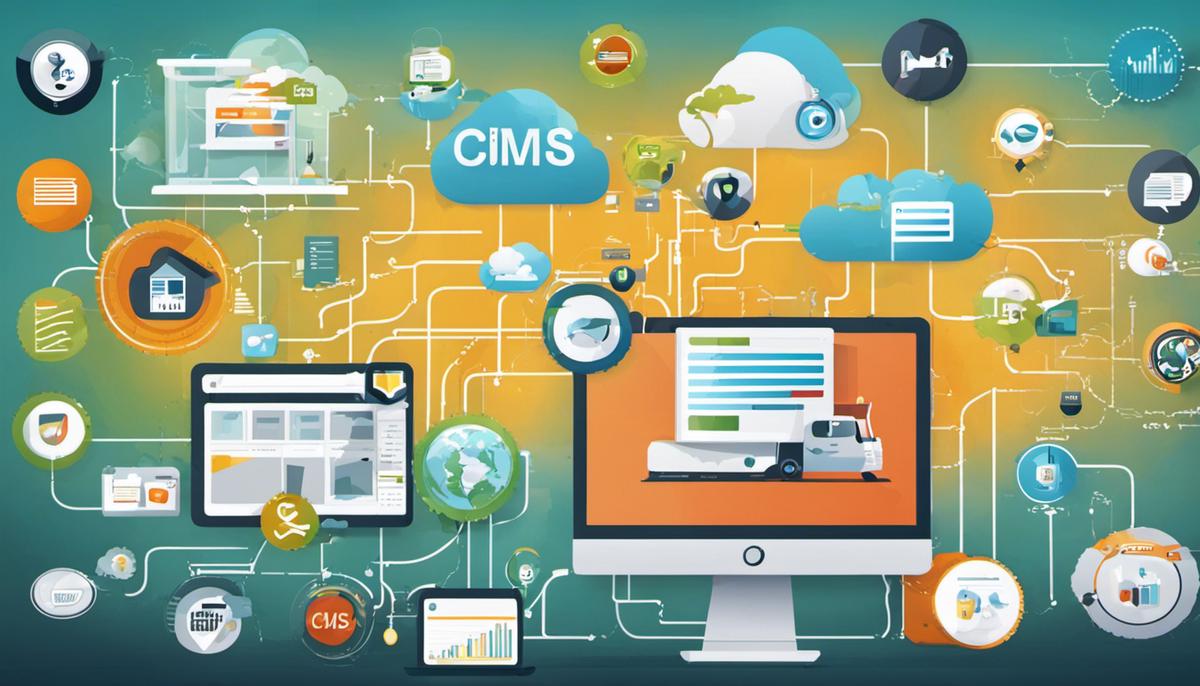With the rapid digital evolution and the increase in mobile device usage, the need for efficient ways to manage and disseminate information has become apparent. Mobile Content Management is a critical player at the confluence of this digital transformation. It is more than just organizing business data; it’s about deploying, securing, and managing business content available on personal and corporate devices effectively. This insightful discourse will offer an in-depth look at mobile content management, its relevance, operation, the systems available, security considerations, and an exploration of future trends. The intent is to understand why mobile content management is an invaluable tool for businesses keen to streamline operations while ensuring data security.
Understanding Mobile Content Management
Unpacking ‘Mobile Content Management’ in the Tech World
Exploring the tech terrain could often be likened to a thrilling rollercoaster ride filled with jargon, where terms like ‘mobile content management’ (MCM) crop up frequently. Understanding this term and how it fits into the larger tech landscape is paramount.
At its core, mobile content management refers to the systemized organization and distribution of content to mobile devices such as smartphones, tablets, and laptops. As technologists revel in the accelerated pace of digital adoption, MCM answers the growing need for secure, efficient, and accessible data management.
Why MCM Matters
With a surge in mobile workforce and remote working trends, managing and distributing content on mobile devices has become a non-negotiable necessity for businesses. It isn’t just about convenience; it’s about speed, dexterity, and the potential to unlock new productivity heights in an increasingly on-the-go world. To this end, MCM brings about security, compliance, and productivity benefits in a digital environment where these elements often come into question.
How Does MCM Work?
MCM operates as part of a broader mobile device management (MDM) or enterprise mobility management (EMM) tool. These software-based solutions enable IT administrators to control, secure, and enforce policies on smartphones, tablets, and other endpoints.
It works in tandem with these systems to ensure secure content distribution. With a consistently evolving tech environment, solutions that enable the push or pull of content to mobile devices in real-time, manage version control, encrypt sensitive data, and delete content remotely are now more vital than ever.
MCM integrates with content management services like SharePoint and OneDrive, allowing seamless access to documents on mobile devices. More futuristic MCM solutions are even delving into AI and Machine Learning capabilities to automate content delivery and enhance user experience.
Functionality and Application
The real beauty of MCM lies in its adaptability. Enterprises across industries from tech to healthcare, construction, and finance can leverage its capabilities for varied purposes. For example, it can streamline content delivery for remote learning or distance training, enable secure file sharing paths for confidential documents, or manage remote data access in compliance with regulations.
Mobile content management isn’t a standalone concept. It’s a cog in the larger tech machine where automation, versatility, and secure data exchange are shaping business as we know it. Being able to realign our understanding of MCM helps us not only navigate the digital business world more efficiently – it provides a launchpad for future tech innovations to truly soar.

How Mobile Content Management Works
As we plunge deeper into the digital age, with workforces increasingly shifting toward a mobile-first approach, Mobile Content Management (MCM) stands as a crucial enabler of this significant move. Having already grasped an understanding of what MCM entails, let’s explore how this system works, its key components, and how it fits in the current tech environment.
To start with, let’s discuss the fundamental workings of MCM. Unlike traditional content management systems, MCM focuses on the provision, regulation, and protection of content accessed on mobile devices. With the integration of Mobile Device Management (MDM) or Enterprise Mobility Management (EMM), MCM can ensure secure content delivery, even on an array devices and locations.
In terms of key components, there are several integral parts of MCM systems. One important element is the content repository that allows storing, retrieving, and managing the digital content. Additionally, a direct syncing mechanism is paramount; it ensures the content is seamlessly updated across all devices, hence fostering productivity and efficiency.
Further, an intuitive user interface simplifies the navigation and optimizes user experience. Also, in-built security features are cardinal elements within an MCM system. These features allow for secure access, file sharing, version control, and audit trails – all essential for maintaining compliance and data protection.
Data encryption and user authentication are other key features to consider in an MCM. They ensure that sensitive content remains secure during storage and transmission, in a world where cyber-attacks are becoming ever more sophisticated.
Beyond this, MCM’s benefits extend far and wide. Take, for instance, its integration with content management services such as SharePoint and OneDrive. By allowing users to access their content remotely, it becomes an even more robust solution boosting productivity and promoting efficiency within an organization’s mobile workforce.
Equally notable is the application of automation within MCM systems. By automating a range of managerial and administrative tasks, MCM systems show their versatility and adaptability in the technology landscape. As such, it serves as a benchmark for how contemporary businesses optimize their technological resources.
Parallel to these integrations, there’s a considerable adoption of MCM across numerous sectors. From healthcare to education and even e-commerce, the utilization taps into diverse industry requirements, making it a versatile asset to many organizations.
In a nutshell, though many debate the merits of maintaining an entirely mobile workforce, the impact of mobile content management systems is undeniably transformative. Emphasizing secure data exchange, automation, and versatility, it is an epitome of how technology can be harnessed to foster organization efficacy, giving a whole new meaning to smart businesses.

Mobile Content Management Systems
Swiftly moving forward, let’s transition into examining the leading mobile content management systems (MCMs) available presently. Primarily, the conversation homes in on three industry heavyweights: Box, Microsoft Intune, and MobileIron. Each of these systems brings forth its unique set of features, strengths, and areas that need improvement, offering varied solutions depending on business requirements.
Starting with Box, it’s most noteworthy for its wide range of integrations with other notable enterprise tools like Salesforce, Google Workspace, and Microsoft Teams. This MCM not just stores, but also helps manage files, images, and multimedia content for real-time collaboration. It employs advanced, multi-layered security measures spanning from encryption, granular controls, to user-friendly features promoting efficient workflows.
Up next, Microsoft Intune asserts its dominance with seamless integration with the full suite of Microsoft Office apps, cementing its place in organizations already in the Microsoft ecosystem. The platform allows both MCM and MDM, providing management and security for enterprise data and apps across varied device types. Drawing from the strength of Azure, Intune’s security capabilities are robust, but they do come with a steeper learning curve for deployment and management.
Lastly, MobileIron offers a comprehensive MCM solution focusing on the mobile-first, cloud-first world. It shines in its user experience design and customizability for different industries. The catch is, the platform may require additional resources for its configuration and maintenance as it’s a more admin-heavy tool.
Digging deeper than surface functionalities, each platform has its peculiarities when compared. Box, for instance, emphasizes collaboration tools and ease of use but might fall short for businesses seeking a holistic MDM solution. Microsoft Intune, while boasting of powerful capabilities leveraging Microsoft’s ecosystem, does present a steep learning curve. MobileIron, loaded with deep-seated customizability and integration capabilities, might require more resources towards configuration and maintenance, which could make it less appealing for small and medium businesses.
When it boils down to MCM selection, an enterprise’s unique needs, the depth of required integrations, resources for system management, along with security and compliance requirements, form the basis of this decision-making process. There isn’t a one-size-fits-all approach to MCM, it highly depends on what aspect value is put on – collaboration, deep-seated capabilities, or customizability.
One thing remains clear – MCMs have made strides in facilitating secure, efficient, and robust data management, sitting on the forward edge of technological convergence. The competition isn’t slowing down, promising continuous improvements and bold innovational steps, to make MCM even more ingrained into an enterprise’s technology stack.

Photo by kylejglenn on Unsplash
Securing Mobile Content Management
Boosting Security of Mobile Content Management: Essential Steps and Smart Practices
Understanding how to promote the security of Mobile Content Management (MCM) and knowing the best practices for this task is quintessential for any tech-minded, savvy individual. In today’s data-driven world, the line drawn between productivity and security is razor thin. With more organizations adopting remote work, MCM security is no longer optional– it’s critical.
One important aspect that needs to be considered is the data privacy aspect of MCM. Permissions and access controls are the backbone of a secure MCM. They ensure that only authenticated users can access files, reducing the chances of sensitive data leakages. It is crucial to have well-defined criteria that determine who can access what content and in what context.
Next is the importance of a robust backup and recovery system. Unexpected data losses can occur at any moment, and the ability to quickly recover can make or break a company’s stance in the market. Therefore, it’s imperative to always maintain a reliable backup of all mobile content and have a well-rehearsed disaster recovery plan.
Further, regular audits are another staple of security practice for MCM. By routinely conducting audits, discrepancies and potential breaches can be quickly identified and solved. Knowing where possible failures can occur and addressing them timely is crucial in ensuring the ongoing security of mobile content.
Secure File Sharing (SFS) protocols also play a significant role. By enabling encryption during file sharing, one can ensure that the content remains secure even when disseminated outside the organization. Application of protocols like Secure Sockets Layer (SSL) or Transport Layer Security (TLS) maintain the integrity of the files during transfers.
Lastly, rapid adoption of cutting-edge technologies like Artificial Intelligence (AI) and machine learning can lift MCM security to new heights. They can help in real-time monitoring and detecting unusual access patterns or changes in system behavior. This ability to detect anomalies in near real-time can drastically shorten response times and limit damage in the event of a security breach.
Now, alongside all these measures, implementing a culture of security awareness is necessary. All the high-tech MCM tools and tactics amount to little if end-users are unaware of basic security hygiene, such as not clicking on suspicious links or sharing sensitive information. Training programs focusing on strengthening security awareness among employees can go a long way in maintaining an additional layer of defense.
Lastly, remember to regularly assess and update these steps in line with the current cybersecurity landscape. Threats and vulnerabilities are an ever-evolving force that can quickly render yesterday’s security measures obsolete. Therefore, maintaining an analytical eye on the latest developments in the tech and cybersecurity world is essential.
In conclusion, safeguarding MCM requires an integrated approach that combines the latest technology with informed and mindful user behavior. It implies being well-versed with mobile device management tools, being prepared for unexpected data loss, bolstering secure file sharing protocols, employing AI and machine learning for threat detection, and building a strong culture of security awareness. Always remember, in a world where data is the currency, security is the bank.

Future Trends in Mobile Content Management
Continuing from the earlier sections, it’s fundamental to delve into the future trends that elevate mobile content management (MCM) systems to the next level. These trends, in these tech-foward times, show a clear trajectory towards increased virtualization, smart integration, and ultra-personalization.
How these trends manifest within MCM systems directly impacts not just how businesses operate, but also how users interact with the digital environment.
As edge computing continues to grow, MCM systems will increasingly harness its potential to enable faster processing and reduce latency. This technological advancement decentralizes data processing, moving it closer to the location where it’s needed, and proving critical for industries with real-time data needs. It’s foreseeable, this technology will effectively reduce content delivery times and significantly enhance user experience.
Artificial Intelligence (AI), too, will progressively make its mark within the realm of MCM. Automated content tagging and categorization, powered by machine learning algorithms, as well as predictive content analytics, promise a significant transformation for MCM systems. As AI-indexed repositories become a norm, searching for content within vast databases is set to become simpler, faster, and more intuitive.
Looking ahead, augmented (AR) and virtual reality (VR) technologies are also set to redefine the mobile content landscape. While currently prevalent in gaming and entertainment sectors, AR and VR have vast untapped potential for content presentation and management. 3D visualization of products, using VR for interactive training sessions or virtual tours – these are just a few ways these immersive technologies will reshape content consumption, making it more engaging and enriching. This shift will, in turn, influence the strategies businesses employ in governing, distributing, and securing content.
In terms of usability, smart integration and personalized user interface will be critical. MCM systems of the future will likely offer an ecosystem of software, tools, and applications that seamlessly integrate with each other. Not only will they ensure consistency and fluidity across different platforms, but they will also prioritize user-specific customization options that enhance productivity and overall ease of use.
These advancements, ripe with opportunities, also bring about an increase in potential risks. Therefore, pushing the boundaries of data security within MCM systems will become mandatory. Techniques including biometric authentication, advanced encryption standards and context-aware access controls are set to play a bigger role in ensuring data integrity, confidentiality, and availability.
In a nutshell, the future of mobile content management is dynamic and disruptive, teeming with transformative technologies. Businesses, therefore, must stay perpetually prepared to adapt to these changes. The ones that do, are the ones that will thrive – turning the challenges into opportunities, and the new trends into their biggest assets.

Mobile Content Management is quickly cementing its place at the heart of digital strategies across industries. It does not just offer a way of storing and accessing data on the move; rather, it provides a comprehensive approach to handle, secure, and distribute digital content efficiently. It’s clear that the future holds exciting developments in mobile content management, with emergent trends set to reshape the landscape. From an increased reliance on cloud technology to the impetus on more secure, adaptive systems, mobile content management will continue to evolve and adapt. This evolution will inevitably underpin the essence of technological transformation, ensuring businesses remain agile and equipped to manage any digital tide that comes their way.






